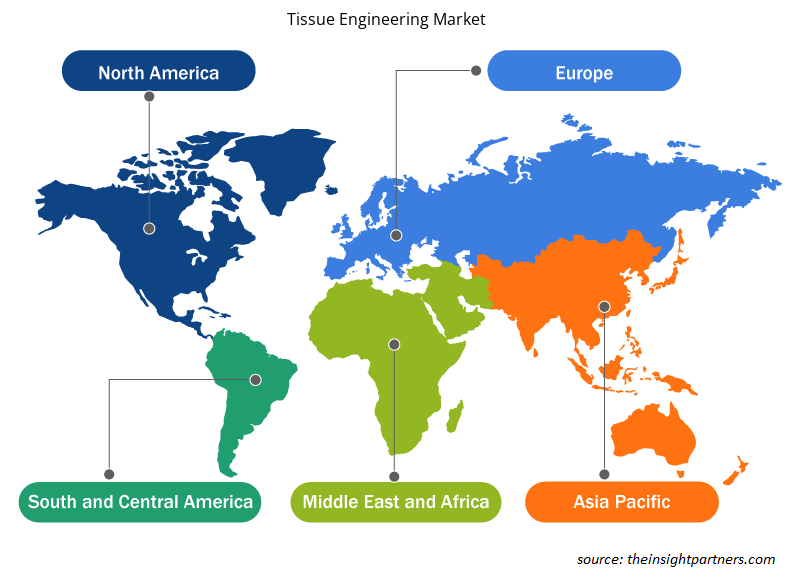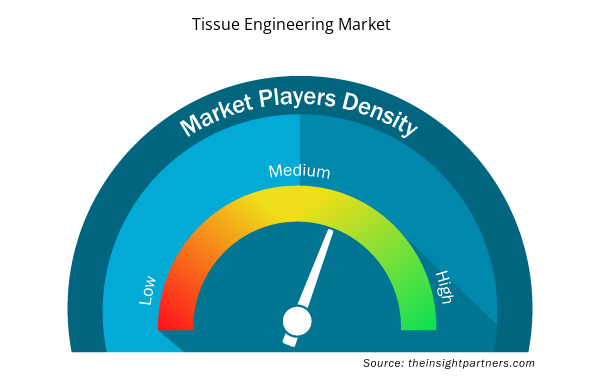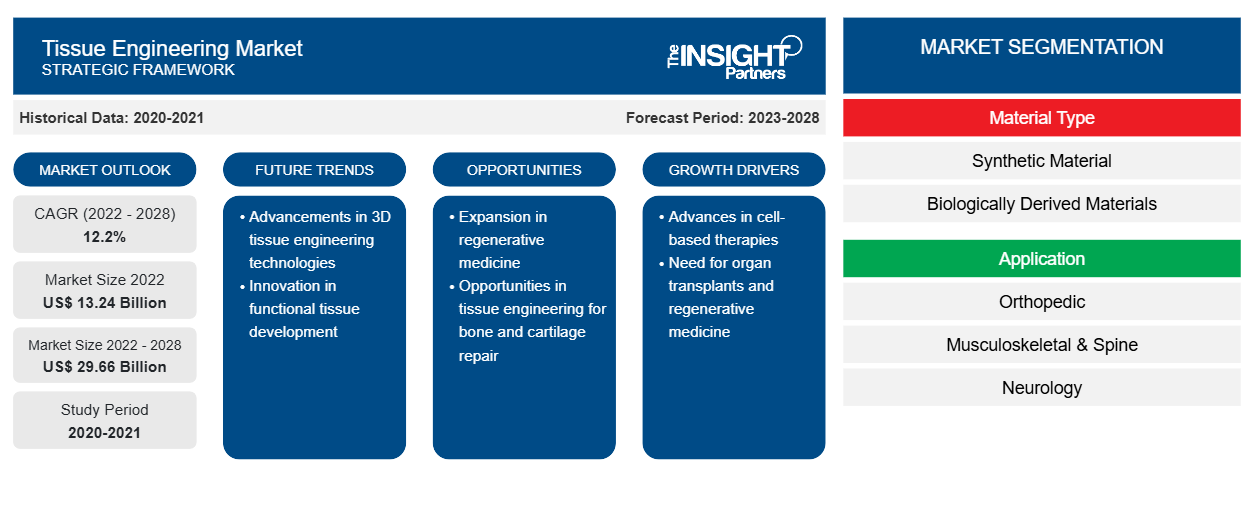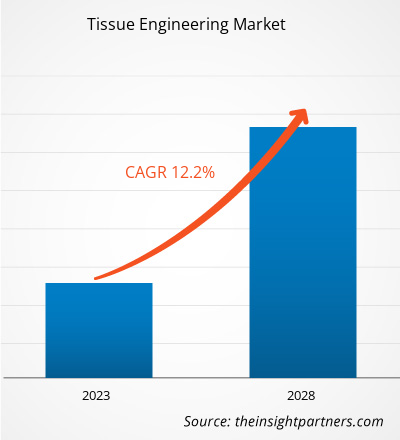[研究报告] 组织工程市场预计在 2022 年将达到 132.3687 亿美元,到 2028 年预计将达到 296.5993 亿美元。预计从 2022 年到 2028 年,复合年增长率为 12.2%。
组织工程是一门生物医学工程学科,它结合使用细胞、工程、材料方法以及适当的生化和物理化学因素来再生、保存、增强或替换各种类型的生物组织。组织工程 (TE) 是一门快速发展的学科,旨在通过将基础物理、化学和生物学知识转化为实用有效的材料或设备和临床策略来修复、替换或再生组织或器官。
组织工程在医学和研究中具有几个主要功能:协助组织或器官修复,包括骨修复(钙化组织)、软骨组织、心脏组织、胰腺组织和血管组织。该领域还研究干细胞的行为。干细胞可以发育成许多不同类型的细胞,并帮助修复身体的各个部位。组织工程的 3D 特性允许在更详细的环境中研究肿瘤结构。它还提供了一个环境来测试这些疾病的潜在新药。随着新兴市场对组织工程的认识不断提高,研发活动数量的增长预计将支持市场增长。发达国家已经采用了组织工程和再生医学方面的技术进步,这有助于扩大全球组织工程市场
全球组织工程市场的范围包括材料类型、应用和地理位置。组织工程市场分析基于北美、欧洲、亚太、中东和非洲以及南美和中美等地区。该报告对全球组织工程市场进行了深入分析,重点关注各种参数,例如市场趋势、技术进步、市场动态以及全球主要市场参与者的竞争格局分析。
定制此报告以满足您的需求
您可以免费定制任何报告,包括本报告的部分内容、国家级分析、Excel 数据包,以及为初创企业和大学提供优惠和折扣
- 获取此报告的关键市场趋势。这个免费样品将包括数据分析,从市场趋势到估计和预测。
市场洞察
道路交通事故和创伤发生率上升,慢性病发病率上升
慢性病发病率上升、创伤和交通事故数量增加是推动组织工程等先进治疗程序市场增长的主要因素。道路事故是全球主要死亡原因之一,因为它们会对骨骼和器官造成严重伤害。根据世界卫生组织的数据,每年约有 2000 万至 5000 万人在道路事故中受伤。组织工程为修复受损组织提供了手术重建、移植和机械设备指导的替代方案。全球组织工程市场的主要驱动力是对有效再生疗法的持续需求,以治疗因生活方式改变、老年人口增加和创伤病例增加而导致的糖尿病、肥胖症和其他疾病的增加。
脊髓损伤 (SCI) 是指脊髓受损,导致其功能暂时或永久改变。根据多学科数字出版研究所 (MDPI) 的数据,全球约有 300 万人患有创伤性脊髓损伤,每年报告的新病例约为 18 万例。脊髓损伤通常会导致毁灭性的长期神经功能障碍,表现为损伤水平以下的运动、感觉或自主神经系统功能障碍。彻底修复或再生受损组织或器官并恢复其功能一直是人类的梦想。组织工程和再生医学 (TERM) 的出现似乎使这成为可能。组织工程结合细胞、支架和生长因子来再生组织或替换受损或患病的组织。
癌症是全球死亡的主要原因之一,影响着大量人口。因此,它给社会带来了巨大的经济负担。据世界卫生组织称,2018 年,全球约有 960 万人死于癌症。然而,越来越多的针对该疾病的有效治疗方法的研究正在对市场增长产生积极影响。基因疗法和细胞疗法正在改变癌症治疗格局;例如,诺华 Kymriah 用于治疗弥漫性大 B 细胞淋巴瘤。更多此类产品的推出将推动对细胞和基因治疗的需求,从而推动未来几年全球组织工程市场的发展。
基于材料类型的洞察
根据材料类型,全球组织工程市场细分为合成材料、生物衍生材料和其他材料。2022 年,生物衍生材料领域有望引领市场。生物材料在组织工程和生物医学设备的开发中发挥着重要作用,可以自然地增加组织的再生潜力,以恢复处于恶化状态的身体机制。生物衍生材料用于在体外创建与其基本身体部位相同的新组织。这些材料还通过在受伤部位控制呈现和按需释放特定趋化因子来帮助组织再生,这些材料具有天然和功能特性,具有组织相似的结构、临时可生物降解的支持基质。然而,在预测期内,合成材料领域在全球组织工程市场中可能实现最高的复合年增长率。
基于应用的洞察
根据应用,全球组织工程市场细分为骨科、肌肉骨骼和脊柱、神经病学、心脏病学和血管、皮肤和外皮、泌尿科、胃肠和妇科、癌症等。预计骨科、肌肉骨骼和脊柱领域将在 2022 年引领市场。然而,预计皮肤和外皮领域在预测期内将在市场上实现最高的复合年增长率。
自从 2020 年 1 月底严重急性呼吸综合征冠状病毒 2 (SARS-CoV-2) 被宣布为国际关注的公共卫生紧急事件以来,医疗专业人员和研究人员一直在敦促对公民进行全面、快速的检测,以制定可以遏制病毒传播的措施。COVID-19 大流行已成为全球最重大的挑战。这一挑战尤其令人恐惧,因为它将导致全球贸易中断导致进口减少,这对全球发展中国家尤其如此。迄今为止,尚未建立针对 COVID 19 的明确治疗方法。因此,缺乏确定性的治疗方法为组织工程市场提供了重大机遇,因为美国 FDA 最近批准使用血浆疗法治疗重症 COVID 19 患者。随着时间的推移,实时聚合酶链反应测试和抗体测试已成为全球医疗保健系统控制疫情的重要技术。供应链中断,以及对 COVID 19 治疗的有效诊断和疗法的巨大需求,使各个地区的医疗保健研究行业处于危急境地。风险主要集中在面临医疗限制和财务状况收紧的新兴市场。COVID-19 疫情还阻碍了该地区的临床试验、药物开发和诊断行业的运营。此外,由于 COVID-19 疫情,涉及组织工程和再生医学的常规研究活动也受到了严重干扰。由于研究中心关闭、医疗设施不足和病例数量增加,许多行业都受到了危机的影响,包括组织工程研究活动。然而,在 COVID-19 疫苗问世后,研究中心已经开始了对干细胞、再生医学和其他疗法的研究。因此,在 COVID-19 疫情的影响之后,欧洲的组织工程市场正受到关注。
该市场中的公司通常采用产品发布和扩张策略来扩大其全球业务范围并满足不断增长的需求。产品创新是公司为满足全球不断变化的客户需求而采取的流行策略之一,这也让参与者在全球范围内保持其品牌知名度。
2022 年 4 月,Organogenesis Inc. 宣布了其 PuraPly AM、Affinity、Apligraf、NuShield、Novachor 和 Organogenesis Physician Solutions 产品线的最新先进伤口护理研究,该研究在 2022 年 4 月 6 日至 10 日在亚利桑那州凤凰城举行的 2022 年先进伤口护理研讨会 (SAWC) 春季会议上进行了展示。
2021 年 7 月,Integra LifeSciences Holding Corporation 宣布 PriMatrix 真皮修复支架在治疗难以治愈的糖尿病足溃疡 (DFU) 方面取得了积极的临床成果。
组织工程市场区域洞察
Insight Partners 的分析师已详细解释了预测期内影响组织工程市场的区域趋势和因素。本节还讨论了北美、欧洲、亚太地区、中东和非洲以及南美和中美洲的组织工程市场细分和地理位置。

- 获取组织工程市场的区域特定数据
组织工程市场报告范围
| 报告属性 | 细节 |
|---|---|
| 2022 年市场规模 | 132.4亿美元 |
| 2028 年市场规模 | 296.6 亿美元 |
| 全球复合年增长率(2022 - 2028) | 12.2% |
| 史料 | 2020-2021 |
| 预测期 | 2023-2028 |
| 涵盖的领域 | 按材料类型
|
| 覆盖地区和国家 | 北美
|
| 市场领导者和主要公司简介 |
|
市场参与者密度:了解其对商业动态的影响
组织工程市场正在快速增长,这得益于最终用户需求的不断增长,这些需求源于消费者偏好的不断变化、技术进步以及对产品优势的认识不断提高等因素。随着需求的增加,企业正在扩大其产品范围,进行创新以满足消费者的需求,并利用新兴趋势,从而进一步推动市场增长。
市场参与者密度是指在特定市场或行业内运营的企业或公司的分布情况。它表明在给定市场空间中,相对于其规模或总市场价值,有多少竞争对手(市场参与者)存在。
在组织工程市场运营的主要公司有:
- 史赛克公司
- 器官发生公司
- 库克生物技术公司
- Integra 生命科学公司
- 3M
免责声明:上面列出的公司没有按照任何特定顺序排列。

- 了解组织工程市场顶级关键参与者概况
组织工程——市场细分
全球组织工程市场根据材料类型和应用进行分析。根据材料类型,市场进一步细分为合成材料、生物衍生材料和其他材料。根据应用,市场细分为骨科、肌肉骨骼和脊柱、神经病学、心脏病学和血管、皮肤和外皮、泌尿科、胃肠和妇科、癌症和其他。根据地域,市场细分为北美(美国、加拿大和墨西哥)、欧洲(法国、德国、英国、西班牙、意大利和欧洲其他地区)、亚太地区(中国、印度、日本、澳大利亚、韩国和亚太地区其他地区)、中东和非洲(沙特阿拉伯、阿联酋、南非和 MEA 其他地区)以及南美洲和中美洲(巴西、阿根廷和 SAM 其他地区)。
公司简介
- 史赛克公司
- 器官发生公司
- 库克生物技术公司
- Integra 生命科学公司
- 3M
- 艾伯维公司(AbbVie Inc.)
- 美敦力
- 齐默邦美
- 百特国际公司
- DePuy Synthes(强生服务公司)
- B. Braun Melsungen AG
- 历史分析(2 年)、基准年、预测(7 年)及复合年增长率
- PEST 和 SWOT 分析
- 市场规模价值/数量 - 全球、区域、国家
- 行业和竞争格局
- Excel 数据集



Report Coverage
Revenue forecast, Company Analysis, Industry landscape, Growth factors, and Trends

Segment Covered
This text is related
to segments covered.

Regional Scope
North America, Europe, Asia Pacific, Middle East & Africa, South & Central America

Country Scope
This text is related
to country scope.
常见问题
The tissue engineering market majorly consists of the players such as Stryker Corporation, Organogenesis Inc., Cook Biotech Inc., Integra Life Sciences Corporation, 3M, Abbvie Inc., Medtronic, Zimmer Biomet, Baxter International Inc., DePuy Synthes (Johnson & Johnson Services, Inc.), and B. Braun Melsungen AG among others.
The biologically derived materials segment dominated the global tissue engineering market and held the largest market share of 52.54% in 2022.
The orthopedic, musculoskeletal & spine segment dominated the global tissue engineering market and held the largest market share of 34.31% in 2022.
Tissue engineering is a biomedical engineering discipline that uses a combination of cells, engineering, material methods, and appropriate biochemical and physicochemical factors to regenerate, preserve, enhance, or replace various types of biological tissues. Tissue Engineering (TE) is a rapidly evolving discipline that aims to repair, replace, or regenerate tissues or organs by converting fundamental physics, chemistry, and biology knowledge into practical and effective materials or devices and clinical strategies. Tissue engineering has several primary functions in medicine and research: Assisting in tissue or organ repair, including bone repair (calcified tissue), cartilage tissue, heart tissue, pancreatic tissue, and vascular tissue. The field also researches the behavior of stem cells. Stem cells can develop into many different cell types and help repair areas of the body. The 3D nature of tissue engineering allows the study of tumor architecture in a more detailed environment. Tissue engineering also provides an environment to test potential new drugs for these diseases. Growth in the number of R&D activities with increasing awareness of tissue engineering in emerging markets is expected to support the market growth. Developed nations have adopted technological advances in tissue engineering and regenerative medicine that contribute to the expansion of the global tissue engineering market.
The factors that are driving the growth of the market are the increasing incidences of chronic diseases, road accidents, and trauma injuries and technological advancements in the field of 3D tissue engineering are expected to boost the growth of the global tissue engineering market.
Trends and growth analysis reports related to Life Sciences : READ MORE..
The List of Companies – Tissue Engineering Market
- Stryker Corporation
- Organogenesis Inc.
- Cook Biotech Inc.
- Integra Life Sciences Corporation
- 3M
- AbbVie Inc.
- Medtronic
- Zimmer Biomet
- Baxter International Inc.
- DePuy Synthes (Johnson & Johnson Services, Inc.)
- B. Braun Melsungen AG
The Insight Partners performs research in 4 major stages: Data Collection & Secondary Research, Primary Research, Data Analysis and Data Triangulation & Final Review.
- Data Collection and Secondary Research:
As a market research and consulting firm operating from a decade, we have published and advised several client across the globe. First step for any study will start with an assessment of currently available data and insights from existing reports. Further, historical and current market information is collected from Investor Presentations, Annual Reports, SEC Filings, etc., and other information related to company’s performance and market positioning are gathered from Paid Databases (Factiva, Hoovers, and Reuters) and various other publications available in public domain.
Several associations trade associates, technical forums, institutes, societies and organization are accessed to gain technical as well as market related insights through their publications such as research papers, blogs and press releases related to the studies are referred to get cues about the market. Further, white papers, journals, magazines, and other news articles published in last 3 years are scrutinized and analyzed to understand the current market trends.
- Primary Research:
The primarily interview analysis comprise of data obtained from industry participants interview and answers to survey questions gathered by in-house primary team.
For primary research, interviews are conducted with industry experts/CEOs/Marketing Managers/VPs/Subject Matter Experts from both demand and supply side to get a 360-degree view of the market. The primary team conducts several interviews based on the complexity of the markets to understand the various market trends and dynamics which makes research more credible and precise.
A typical research interview fulfils the following functions:
- Provides first-hand information on the market size, market trends, growth trends, competitive landscape, and outlook
- Validates and strengthens in-house secondary research findings
- Develops the analysis team’s expertise and market understanding
Primary research involves email interactions and telephone interviews for each market, category, segment, and sub-segment across geographies. The participants who typically take part in such a process include, but are not limited to:
- Industry participants: VPs, business development managers, market intelligence managers and national sales managers
- Outside experts: Valuation experts, research analysts and key opinion leaders specializing in the electronics and semiconductor industry.
Below is the breakup of our primary respondents by company, designation, and region:

Once we receive the confirmation from primary research sources or primary respondents, we finalize the base year market estimation and forecast the data as per the macroeconomic and microeconomic factors assessed during data collection.
- Data Analysis:
Once data is validated through both secondary as well as primary respondents, we finalize the market estimations by hypothesis formulation and factor analysis at regional and country level.
- Macro-Economic Factor Analysis:
We analyse macroeconomic indicators such the gross domestic product (GDP), increase in the demand for goods and services across industries, technological advancement, regional economic growth, governmental policies, the influence of COVID-19, PEST analysis, and other aspects. This analysis aids in setting benchmarks for various nations/regions and approximating market splits. Additionally, the general trend of the aforementioned components aid in determining the market's development possibilities.
- Country Level Data:
Various factors that are especially aligned to the country are taken into account to determine the market size for a certain area and country, including the presence of vendors, such as headquarters and offices, the country's GDP, demand patterns, and industry growth. To comprehend the market dynamics for the nation, a number of growth variables, inhibitors, application areas, and current market trends are researched. The aforementioned elements aid in determining the country's overall market's growth potential.
- Company Profile:
The “Table of Contents” is formulated by listing and analyzing more than 25 - 30 companies operating in the market ecosystem across geographies. However, we profile only 10 companies as a standard practice in our syndicate reports. These 10 companies comprise leading, emerging, and regional players. Nonetheless, our analysis is not restricted to the 10 listed companies, we also analyze other companies present in the market to develop a holistic view and understand the prevailing trends. The “Company Profiles” section in the report covers key facts, business description, products & services, financial information, SWOT analysis, and key developments. The financial information presented is extracted from the annual reports and official documents of the publicly listed companies. Upon collecting the information for the sections of respective companies, we verify them via various primary sources and then compile the data in respective company profiles. The company level information helps us in deriving the base number as well as in forecasting the market size.
- Developing Base Number:
Aggregation of sales statistics (2020-2022) and macro-economic factor, and other secondary and primary research insights are utilized to arrive at base number and related market shares for 2022. The data gaps are identified in this step and relevant market data is analyzed, collected from paid primary interviews or databases. On finalizing the base year market size, forecasts are developed on the basis of macro-economic, industry and market growth factors and company level analysis.
- Data Triangulation and Final Review:
The market findings and base year market size calculations are validated from supply as well as demand side. Demand side validations are based on macro-economic factor analysis and benchmarks for respective regions and countries. In case of supply side validations, revenues of major companies are estimated (in case not available) based on industry benchmark, approximate number of employees, product portfolio, and primary interviews revenues are gathered. Further revenue from target product/service segment is assessed to avoid overshooting of market statistics. In case of heavy deviations between supply and demand side values, all thes steps are repeated to achieve synchronization.
We follow an iterative model, wherein we share our research findings with Subject Matter Experts (SME’s) and Key Opinion Leaders (KOLs) until consensus view of the market is not formulated – this model negates any drastic deviation in the opinions of experts. Only validated and universally acceptable research findings are quoted in our reports.
We have important check points that we use to validate our research findings – which we call – data triangulation, where we validate the information, we generate from secondary sources with primary interviews and then we re-validate with our internal data bases and Subject matter experts. This comprehensive model enables us to deliver high quality, reliable data in shortest possible time.


 获取此报告的免费样本
获取此报告的免费样本